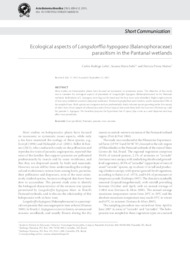Ecological aspects of Langsdorffia hypogaea (Balanophoraceae) parasitism in the Pantanal wetlands.
Ecological aspects of Langsdorffia hypogaea (Balanophoraceae) parasitism in the Pantanal wetlands.
Author(s): LEHN, C. R.; SALIS, S. M. de; MATTOS, P. P. de
Summary: Most studies on holoparasitic plants have focused on taxonomic or systematic issues. The objective of this study was to examine the ecological aspects of parasitism of Langsdorffia hypogaea (Balanophoraceae) in the Pantanal wetlands. Individuals of L. hypogaea were dug out by hand and the host trees were identified. Eighty-eight percent of host trees exhibited zoochory dispersal syndrome. Protium heptaphyllum and Cordiera sessilis represented 50% of the sampled trees. Both species are evergreen and are preferentially shade-tolerant species growing under the canopy of other trees. Fecal sample of collared peccaries (Pecari tajacu) had seeds from both the host tree (Protium sp.) and the parasite L. hypogaea. We therefore propose the hypothesis that P. tajacu play a role as a seed disperser and may affect root parasitism.
Publication year: 2015
Types of publication: Journal article
Unit: Embrapa Pantanal
Keywords: Cerrado, Hospedeiro vegetal, Host plants, Pantanal, Parasite, Parasites, Parasito, Raiz, Root, Savanna, host specificity
Observation
Some of Embrapa's publications are published as ePub files. To read them, use or download one of the following free software options to your computer or mobile device. Android: Google Play Books; IOS: iBooks; Windows and Linux: Calibre.
Access other publications
Access the Agricultural Research Database (BDPA) to consult Embrapa's full library collection and records.
Visit Embrapa Bookstore to purchase books and other publications sold by Embrapa.

